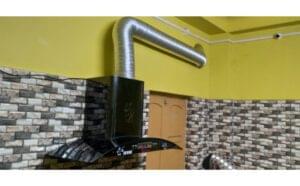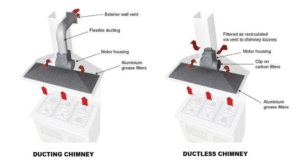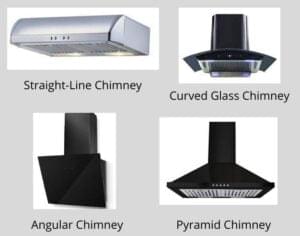Kitchen chimneys come in two main types – ducted and ductless (recycling) – and the right choice depends on your kitchen setup, cooking style, and budget.
Ducted Kitchen Chimney
what is ducted kitchen chimney and How it Works
-
The chimney’s suction motor pulls in smoke, grease particles, and hot air.
-
The air passes through filters (baffle/mesh/cassette).
-
Cleaned air (mostly grease-free) is pushed out through a duct/pipe to the outside of the house.
Key Features
-
Needs a duct/pipe (usually 6–8 inch diameter) connected to an external outlet.
-
Uses baffle filters (common in India) that require cleaning but are long-lasting.
-
Removes smoke, odor, and heat completely from the kitchen.
-
Best for heavy-duty Indian cooking (deep frying, tadka, masala).
Advantages
-
Best for Indian cooking (lots of frying, tadka, spices).
-
Removes heat, smoke, grease, and odor outside the kitchen.
-
More powerful suction → better air quality.
-
Less frequent filter cleaning (if using baffle filters).
-
Long-term cost-effective.

Disadvantages
-
Requires duct installation (needs space & proper outlet).
-
Installation is costly and less flexible.
-
Not suitable for small apartments with no duct provision.

Ductless (Filter-based / Recirculating) Chimney
what is working of ductless chimney
A ductless kitchen chimney (also called a recirculating chimney) works differently from a ducted one. Instead of throwing smoke outside, it filters and recirculates the air back into the kitchen.
How It Works
-
The chimney sucks in smoke, steam, grease, and odor from cooking.
-
The air passes through grease filters (mesh or baffle) → which trap oil & grease particles.
-
Then it goes through charcoal filters → which absorb smoke and cooking odors.
-
The filtered air is released back into the kitchen.

Key Features
-
No duct/pipe needed – air is recirculated.
-
Charcoal filters are the main component → need replacement every 3–6 months.
-
Easy to install in flats, rented homes, or where ducting is not possible.
-
Doesn’t remove heat (kitchen may stay warm).
Advantages
-
Easy to install (no duct needed).
-
Flexible placement → suitable for apartments and rented homes.
-
Cheaper installation.
-
Removes odor through charcoal filters.
Disadvantages
-
Less effective for heavy Indian cooking → smoke & heat remain in kitchen.
-
Charcoal filters need frequent replacement (every 3–6 months).
-
Doesn’t expel heat → kitchen can still feel warm.
-
Higher running cost due to filter replacement.

Which is Better?
-
If you cook Indian food with lots of frying, spices, curries → Ducted chimney is much better.
-
If your cooking is light, less oily, minimal frying (e.g., salads, boiling, light continental) or you live in a rented flat without duct option → Ductless chimney is more practical.
👉 General Rule:
-
Ducted = Best performance
-
Ductless = Best flexibility
